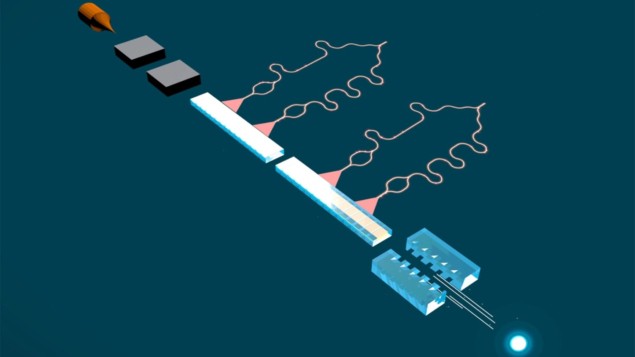
A new laser-driven device that can both confine and accelerate electrons over distances of about a millimetre has been developed by researchers in the US. By combining advances in nanoscience, lasers and vacuum technology, Payton Broaddus and colleagues at Stanford University say they have developed the highest-performing dielectric laser accelerator (DLA) to date.
As well as driving charged particles like electrons to high kinetic energies, a useful accelerator must also be able to confine the particles into a narrow beam. Furthermore, the beam must also be as close to monoenergetic as possible.
In modern facilities, this is usually done using radio-frequency (RF) cavities that are coated with copper or more recently with a superconductor such as niobium. When driven by powerful RF signals, these resonant cavities develop very high voltages that accelerate particles a very specific energies. However, there are physical limits on the maximum particle energies that can be achieved in this way.
“Making the electromagnetic fields too large can result in damage to the [cavity] walls, which ruins the machine,” Broaddus explains. “This is currently a major limitation in all conventional accelerators and limits the safe acceleration gradient to tens of megaelectronvolts per metre.” Indeed, this is the main reason why accelerators keep getting bigger and more expensive in order to achieve higher particle energies.
Alternative accelerator designs
To create more compact devices, researchers worldwide are exploring a variety of alternative accelerator technologies, with the goal of achieving the highest possible acceleration gradient over the shortest distance.
One promising technology is the DLA, which was first conceived in the 1950s. Instead of directing an RF signal at a conducting cavity, a DLA involves firing a laser across a tiny channel within a dielectric material. This creates an alternating electric field within the channel, which acts as a resonant cavity. By optimizing the nanostructure of the cavity and by the careful timing of when electrons are sent through the channel, the particles are accelerated.
While the physics of this setup is broadly similar to more conventional accelerator designs, it offers a vastly higher acceleration gradient. This could be used to shrink the size of accelerators – at least in principle.
“The fields these dielectrics can survive from lasers are one to two orders of magnitude higher than what copper can handle from RF waves, and thus, theoretically, can have an acceleration gradient one to two orders of magnitude higher,” Broaddus explains. However, he points out that shrinking the width of the cavity down by six orders of magnitude introduces challenges – including how to keep the electrons confined in a beam, and not having them crash into the walls of the cavity.
Now, Broaddus and colleagues have addressed this challenge by drawing on three technological advances. These are the ability to create very precise semiconductor nanostructures; the ability to produce bright, coherent femtosecond laser pulses with stable repetition rates; and the ability to maintain ultrahigh vacuum within millimetre-length semiconductor cavities.
New nanostructures and pulses
By the careful design of the nanostructures and the use of specially-shaped laser pulses, the team was able to create electric fields within their new cavity that focus electrons into a beam.
This allowed the team to accelerate a confined beam of electrons a distance of 0.708 mm, boosting its energy by 24 keV. “This represents an order of magnitude increase in both figures of merit compared with previous accelerators,” explains Broaddus.

Accelerator-on-a-chip created by inverse-design algorithm
Based on their latest achievement, the team are confident that DLAs could vastly improve researchers’ ability to achieve sub-relativistic electron energies. “DLAs can now be treated as an actual accelerator technology, where we can extract traditional accelerator parameters from our devices and which can be compared to other accelerator technologies,“ Broaddus explains.
In turn, these improvements could pave the way for new discoveries in fundamental physics, and may even offer new benefits in fields including industry and medicine.
The research is described in Physical Review Letters.
- SEO Powered Content & PR Distribution. Get Amplified Today.
- PlatoData.Network Vertical Generative Ai. Empower Yourself. Access Here.
- PlatoAiStream. Web3 Intelligence. Knowledge Amplified. Access Here.
- PlatoESG. Carbon, CleanTech, Energy, Environment, Solar, Waste Management. Access Here.
- PlatoHealth. Biotech and Clinical Trials Intelligence. Access Here.
- Source: https://physicsworld.com/a/dielectric-laser-accelerator-creates-focused-electron-beam/



